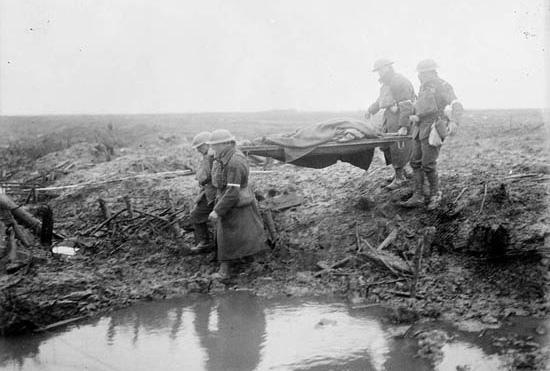My steel helmet saved me
First World War Audio Archive
My steel helmet saved me
Transcript
Soldiers reading the newspaper.
knife saved me life. There was a time in the battery when they were making souvenirs, coming on the tail end of the war. Everything that they made souvenirs out of was German, shell cases and... well, they started on the fuses, and that’s where the big trouble is. There’s detonators in there that you could take them apart, but you got to know what you’re doing. If you make a mistake then that’s it. So, I was sitting alongside of this fellow that was taking it apart. I took one apart and I paid no attention to him and another fellow on the other side of him, he wasn’t paying any attention to him. At last he turned to me and asked me for my knife. I put me hand in my pocket for the knife and it was gone and I knew that I had just seen a fellow that I had lent it to passing a few minutes ago going up to the canteen. So I says to myself, “I better go and get that knife or I’ll forget about it and I’ll lose it.” So, I went over and got to the canteen when Bang-o!! This fellow made a mistake. I wasn’t at the canteen too long when they were carrying the other fellow away on a stretcher. So I don’t know what would have happened if I'd have sat there. See how close you can come to death and still miss it? Well, another time was during a German retreat. Sometimes we’d be moved three times a day. We had twenty lorries or so with us and we had to load all them and unload them three times in one day. That’s exhausting work. We hadn’t time hardly to eat or sleep. Well anyway, this day we was out of range.Soldier standing amongst rubble.
We had to move our guns. So we got the lorries and we pulled them up and coming back to the last one there was a crater in front of one of the guns that you could sink a house in. The reserve troops were swarming around where our guns were following up the battle lines. The Germans were dropping bombs and shells. Well, anyway, we hooked up and I jumped in with the driver and away we went. Well, we hadn’t gone far when a shell landed in front of the lorry a little piece. A piece of the shell came through the visor and struck me on the helmet. So the driver put the brakes on and waited for a few minutes to see how things were going and things looked not too bad. So he put her into gear and away we went. We got through all right. Oh, it was wonderful to come through, but there was a lot of people, a lot of soldiers that didn’t come through.Description
Mr. Turner describes the role of his pocket knife and helmet in saving his life.
Brenton Harold Turner
Brenton Harold (Jack) Turner was born in O’Leary, Prince Edward Island on September 24, 1889. His father was a general merchant, and he worked in the family business. Mr. Turner enlisted in Charlottetown on September 25, 1915. He sailed to England aboard the Lapland, arriving in December, 1915. He trained in Horsham, and then went into action as a Corporal in the 2nd Canadian Siege Battalion, arriving in France in May, 1916. Mr. Turner saw action at the Somme, Vimy and Passchendaele. Despite orders to turn in all cameras, Mr. Turner smuggled a German-built 2" x 3" format camera in his clothes behind the front lines and took approximately 100 photographs from the war zone. After the war, he returned to Canada aboard the Mauritania, married, and became a farmer. Mr. Turner died on October 6, 1989.
Meta Data
- Medium:
- Video
- Owner:
- Veterans Affairs Canada
- Duration:
- 2:46
- Person Interviewed:
- Brenton Harold Turner
- War, Conflict or Mission:
- First World War
- Location/Theatre:
- Europe
- Battle/Campaign:
- Vimy
- Branch:
- Army
- Units/Ship:
- 2nd Canadian Siege Battery
- Rank:
- Corporal
- Occupation:
- Artillery
Attestation
Related Videos
- Date modified:




